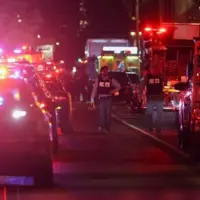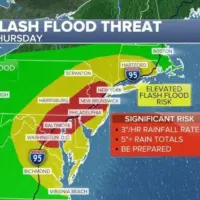
(NEW YORK) — After a gunman opened fire in a New York City office building and killed four people, experts expressed some concerns regarding security in workplace environments.
Four people were killed and one was injured on Monday after police say 27-year-old Shane Devon Tamura entered a Midtown Manhattan office building — which is home to the NFL headquarters — wearing body armor and opened fire with a high-powered rifle, according to authorities.
Donald Mihalek, a senior ABC News law enforcement contributor and retired United States Secret Service agent, said these types of workplace shootings are on the rise due to people — employees and those not affiliated with the company — feeling more comfortable with vilifying corporations and taking out their grievances through violence.
From 1994 to 2021, 16,497 U.S. workers were “intentionally killed while at work,” according to 2024 study. Other recent shootings that occurred at workplaces include the 2021 incident at an office complex in Southern California, killing four people, and a 2023 incident at a bank in Kentucky, killing five and injuring eight.
“Corporations are now feeling what governments have felt for many years, being targeted, being vilified,” Mihalek told ABC News.
So, what was learned from this incident and how can office buildings help mitigate these shootings from escalating?
Security outside an office building and artificial intelligence monitoring potential threats
On Monday, the suspect emerged from a double-parked BMW with an M4-style weapon Palmetto State Armory PA-15 rifle, entered the lobby alone, immediately opened fire on a New York Police Department officer and sprayed the lobby with bullets.
Richard Frankel, an ABC News contributor and retired FBI special agent, said Tamura’s ability to leave his vehicle double-parked and walk with a visible weapon “without anyone even thinking about it or causing concern” is “a little bit of an issue.”
“It’s crazy that he was able to walk on a Manhattan street into a building and not be seen carrying a long gun,” Frankel told ABC News. “How was he able to just walk with no one seeing him carrying an assault weapon and actually having it dangle out from his jacket?”
To prevent something similar happening in the future, Frankel said a corporation increasing its security presence outside the building — by establishing a private government partnership or hiring individuals — could help prevent the threat from actually entering the presence.
Frankel also said there is artificial intelligence and video technology used by federal buildings that could “observe what somebody is doing and consider whether that’s a threat or not.” If an armed individual is approaching the building, “an alarm would go off” with this technology, Frankel said.
Understanding the difference between handgun and rifle violence
With this shooting, the gunman opened fire using a rifle, which is a “more powerful weapon” that can travel a greater distance and has a greater capacity to penetrate compared to a handgun, Mihalek said.
Thus, corporations should think to make a “significant investment” in armor and bulletproof glass around the entranceways of the building, he said. While it is “very difficult” for someone to protect themselves from a rifle, a “man trap system” — where somebody has to be let through different phases of the building in order to get to the heart of the structure — could also help slow down the attack.
Conducting threat assessments
Mihalek also recommends that corporations conduct threat assessments, where a business identifies individuals — both employees and those not affiliated with the company — who may be potential threats of violence due to a recent termination, relationship turmoil or social media posts showing grievances toward the company or individuals at the company.
While it is unclear whether the suspect in Monday’s shooting was posting threats on social media, officials had found a note in his pocket accusing the National Football League of concealing the dangers to players’ brains to maximize profits, sources said. So “chances are he had some type of social media presence or online presence somewhere where he might have said a few things about the NFL,” which could have alerted of a potential threat beforehand.
This behavioral assessment is a holistic process that detects, identifies and processes potential threats, Mihalek said.
“This individual could have perhaps said something concerning online or elsewhere but if no one reports it or is looking, it can’t be detected,” Mihalek said.
Implementing active shooter drills, training for employees
Along with buildings implementing additional security and keeping a lookout for potential threats, both Mihalek and Frankel said corporations should implement routine active shooter drills and provide both online and in-person training conducted by local law enforcement.
Mihalek said buildings should also partner with local law enforcement and emergency medical services so they can “understand the layout of the building” so that they are prepared for a potential threat to that particular office space.
The Department of Homeland Security also has basic active shooter protocols instructing individuals in an active shooter situation to “run, hide and fight,” which Mihalek said is used in many schools and is “simple, effective and it works.”
ABC News’ Aaron Katersky contributed to this report.
Copyright © 2025, ABC Audio. All rights reserved.















